Middle
Eastern Perceptions and Perspectives
by Peter Flaherty
“Plucky
little Jordan. In the middle of a tough neighbourhood, stuck between
'I-raq' and a hard place (Israel and the Palestinian Territories,
Lebanon, Syria, and Saudi Arabia), surrounded by political extremism
and the violence of the Israeli-Palestinian struggle, devoid of
the region’s great oil reserves and running out of water,
it’s been a tough few years for the tiny kingdom” —
Bradley Mayhew, Lonely Planet Guide to Jordan, April 2006.
Anticipating
When I first learned
that I had been invited to participate in a media trip to Jordan,
to be hosted by that country’s tourist board, I was sitting
in a hotel room in Rome, Italy. It was mid-summer 2006, and the
always-troubled Middle East was erupting into an even greater state
of fury than usual. Israeli forces were battling against Hezbollah
guerrillas in Lebanon and also engaged in a tense standoff with
the radical Hamas government of the Palestinian territories over
the capture of one of their soldiers. Bombs were falling on Beirut,
and it looked as if the entire region might explode into a wider
conflict at any moment. Needless to say, I was surprised, intrigued,
and somewhat apprehensive about the prospect of a visit to Jordan,
a country that was right in the middle of that violent part of the
world, at that particular moment.
There had been some preliminary
discussions of a tour a few months before, but once the hostilities
started, I was almost certain that the prospect of an early trip
to Jordan would be placed firmly on the back burner until the situation
calmed down, whenever that might be. But true to its plucky, take-risks
image, the Jordan North America Tourist Board had decided that this
was in fact the best time to challenge some widespread misperceptions
about the country. The first of these, of course, was that it was
in fact a dangerous place for foreign travellers to visit because
of conflicts raging in other parts of the Middle East. Our group
was especially invited to see for itself the many fascinating and
diverse attractions of the Hashemite Kingdom, which are more specifically
profiled in the articles accompanying this overview. But we were
also being given the first-hand opportunity to gain a new perspective
as to just how different this country is from the rest of that conflict-plagued
region, and why it was indeed a stable and safe destination for
prospective tourists to consider for an unforgettable visit.
Contextualizing
Jordan is indeed a small
country, only 96,188 square. kilometres in area. It is almost landlocked,
bordering Israel and the Palestinian Territories to the west, Syria
to the north, and Iraq and Saudi Arabia to the east. The port of
Aqaba, at the northern tip of the Red Sea, is the country’s
only access to salt water. From that historic city, where the Arab
revolt against Ottoman Turkish rule began during World War I, one
travels north along the banks of the Wadi Araba to the shores of
the Dead Sea. From there the Jordan River stretches north to the
Sea of Galilee, forming the long and sometimes tense border with
Israel. Jordan’s population is approximately six million,
with an estimated 1.7 people of Palestinian origin now citizens
of the country. In addition, there has been a large wave of Iraqi
immigration since the beginning of the conflict there in 2003. Amman,
the country’s capital and by far the largest city, is home
to almost a third of its total inhabitants, with a growing population
of almost two million. Jordan is a predominantly Muslim country,
with 80 per cent of its people adhering to Sunni Islam and another
15 per cent professing the Shi’ite branch of the faith. The
country’s small minority Christian population (about 5 per
cent), enjoys complete religious freedom and is prominent in the
country’s economic, social, and political life. Jordan is
a constitutional monarchy, under the rule of King Abdullah II, who
ascended the Hashemite throne following the death of his father,
the world-renowned and much beloved King Hussein, in 1999.
Realizing
As the Royal Jordanian
aircraft carrying the group from New York to Amman crossed the eastern
Mediterranean, I realized with a mixture of excitement and apprehension
that I was indeed entering the Middle East. After the rugged Greek
islands passed from view, the incredibly blue waters of the Mediterranean
gave way to a stretch of sandy seacoast and a modern city below.
We were flying directly over Tel Aviv, the capital of Israel. Only
a short distance north of that city, Hezbollah rockets had recently
been flying, until the late-summer cease-fire had finally taken
effect, making our trip actually possible. From there we crossed
the craggy, arid, and mountainous terrain of the West Bank, and
from the plane’s window I could spot both the isolated, neatly-laid-out
Jewish settlements occupying the high ground and the sprawling Palestinian
towns stretched out in the valleys below. The political geography
of that long, bitter, and seemingly intractable conflict was there
before my eyes as the plane began its final descent into Amman’s
modern Queen Alia International Airport. As it touched down on a
runway that appeared to have been built in the middle of the desert,
my sense of anticipation mounted. This was my first visit to the
Middle East. Most of the people I had talked to in the weeks before
the visit, including close friends and family members, had expressed
strong reservations and concerns to me about my plans. What would
I experience here in Jordan? How would our group be received? Would
we find ourselves on the immediate fringe of a war zone? What indeed
would the next two weeks hold for us?
Remembering
Jordan is a relatively
new country occupying an ancient land. It only gained its independence
from British rule in 1946, having been ruled by that country as
a League of Nations mandate since the end of World War I. King Abdullah
I, the great-grandfather of the present monarch, became the nation’s
first ruler. Along with his elder brother Faisal, Abdullah had played
a major role in assisting British forces struggling against the
Ottoman Turks in the Middle East during the war. It was at this
time that the legendary British officer T.E. Lawrence, or “Lawrence
of Arabia” had allied himself with the two brothers in their
campaign for an independent Arab state in the Middle East. But instead
of full self-government, Faisal and Abdullah had to settle for limited
autonomy as rulers of the new states of Iraq and Transjordan, which
the British authorities established as their mandated territories
under the terms of a secret agreement with France, which was in
turn given control over Syria. Iraq, and Jordan thus became separate
entities, each one ruled by a different member of the Hashemite
royal family, and this was to remain the case until a bloody coup
in 1958 toppled the monarchy in Iraq, paving the way for the eventual
rise to power of dictator Saddam Hussein.
But Jordan has been the
site of continuous human habitation since before the dawn of recorded
history. The remains of some of the oldest Neolithic (new stone
age) settlements in the world have been discovered near Petra, and
along the banks of the Jordan River, dating back over 9000 years.
Throughout the course of ancient history, Jordan has tended to find
itself on the margins rather than at the centre of the succession
of great empires that have risen, ruled, and fallen over the millennia.
Egyptians, Assyrians, Babylonians, Hittites, Greeks, Romans, Arabs,
Turks, and European Crusaders have all crossed through Jordan throughout
many centuries of history, fighting, trading, establishing settlements,
and leaving their own religious, cultural, and architectural traces
that can still be seen across the country.
During the Bronze Age,
3000-2100 BCE, a Semitic people known as the Canaanites emerged
as the dominant force in the area, establishing important trade
links with their Egyptian, Syrian, and Palestinian neighbours. Between
1500 and 1200 a number of tribes, including most notably the Hebrew-speaking
people who came to be known as the Israelites, had entered the region.
As the Iron Age progressed, from 1200 to 330 BCE, three kingdoms
dominated Jordan: the Edomites in the south, the Moabites in the
centre, and the Ammonites to the north. Each kingdom had its own
capital, and it was during this period that Biblical scholars believe
the journey of Moses and his Hebrew followers to the Promised Land
may have occurred. To this day it is possible to visit Mount Nebo,
where it is believed God showed Moses the “land of milk and
honey,” now a part of the Palestinian Territories, stretching
into the distance from the summit of Mount Nebo, one of the holiest
sites in Christendom.
Over the following centuries,
Jordan fell under the rule of the great Hebrew King Solomon, the
Babylonian ruler Nebuchadnezzar, and finally the legendary Macedonian
conqueror Alexander the Great, who took control of the region during
his campaigns against the Persians in 333 BCE. Following Alexander’s
early death, one of his trusted generals, Seleucus, established
a dynasty that was to rule Jordan and much of the Middle East until
the advent of Roman domination, beginning in the first century before
the birth of Christ. It was at this time that the great city of
Petra was literally carved from the pink rocks of the mountains
of southern Jordan. The Nabataeans, the mysterious people who built
Petra, were an Aramaic-speaking tribe whose control of the key trade
routes between the Arabian Peninsula and the Red and Mediterranean
seas gave them great economic and political influence in the region.
The high point of their civilization occurred during the reign of
the great kind Aretas IV, during the first century BCE, shortly
before the Nabataean kingdom fell under the domination of Rome.
Experiencing
Traces of the Roman Empire
can still be found throughout Jordan. The impressive ruins of the
city of Jerash, north of Amman, known as Gerasa in Roman times,
are among the best preserved in the entire Mediterranean region,
and stand as a silent testimony to the extent and power of that
great empire. Once the Roman Empire became officially Christian,
under the reign of the Emperor Constantine in the 4th century, thousands
of pilgrims began to flock to the major Biblical sites dotted throughout
Jordan. These include Mount Nebo, Lot’s cave, and most significantly
Bethany beyond the Jordan River, where John the Baptist is supposed
to have baptized Jesus Christ. Some of the earliest churches in
Christianity were built on these sites and their ruins, many adorned
with beautiful mosaics, can still be seen and marvelled at today.
But the era of Christian domination came to a sudden and decisive
end by the middle of the 7th century, when the forces of Islam swept
out of the Arabian Peninsula to gain control of the entire Middle
East and North Africa, eventually advancing as far as Spain.
Understanding
Jordan’s Islamic
heritage is profound but its traditional tolerance of other religions,
most notably Christianity probably dates from the period of the
Umayyad dynasty, that held sway over the Middle East from its glittering
capital of Damascus in Syria. The Umayyads practised a moderate,
enlightened form of Islam that encouraged culture and the arts,
and was open-minded in its dealings with Jewish and Christian minorities
under its rule.
|
|
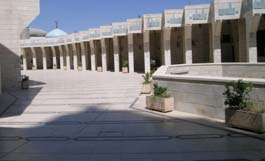
Cultivated
Amman, by Bob Fisher
Amman
is a vibrant and modern city but one that, at the same time, has preserved
many historical and cultural treasures.
Read
more...
 To view a slideshow of Amman,
CLICK
HERE
To view a slideshow of Amman,
CLICK
HERE
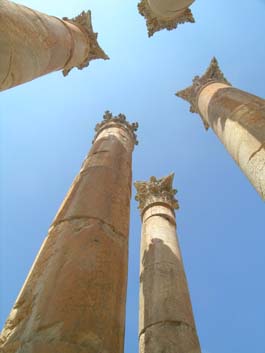
The
Many Lives of Jerash, by Bob Fisher
One
of the best-preserved Roman ruins in the Mediterranean area, Jerash
is notable especially for its openness and visual beauty. Read
more...
 To
view a slideshow of Jerash,
CLICK HERE
To
view a slideshow of Jerash,
CLICK HERE
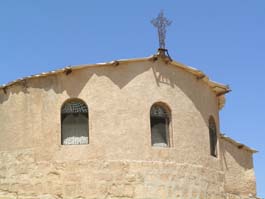
Mosaics
and Moses: The View From Jordan, by Peter Flaherty
Jordan
is Biblical history and the crossroads of many ancient cultures,
religions, and civilizations. Three of the most spectacular historica
and archeological sites in Jordan are Mt. Nebo, Madaba, and Kerak.
Read
more...
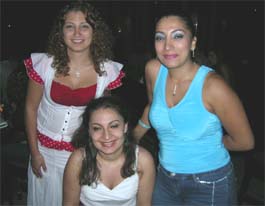
Incomparable
Petra, by Peter Flaherty
The
world-famous “rose city” of Petra is one of the greatest
and most beautiful archeological sites in the world. Read
more...
 To
view a slideshow of Petra, CLICK
HERE
To
view a slideshow of Petra, CLICK
HERE

The
Silence and Serenity of Wadi Rum, by Bob Fisher
To
travel through — and to spend the night in — this vast
and monumental landscape is a once-in-a-lifetime experience. Read
more...
 To view a slideshow of Wadi Rum,
CLICK
HERE
To view a slideshow of Wadi Rum,
CLICK
HERE

From
the Red to the Dead, by Peter Flaherty
Travelling
the length and breadth of Jordan is an opportunity to contextualize
the geography and topography of the Middle East — and to gain
a new visual and cultural perspective. Read
more...
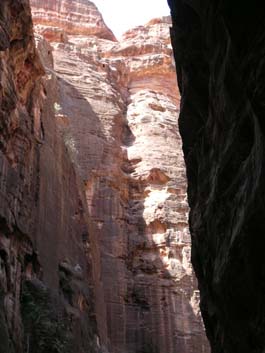
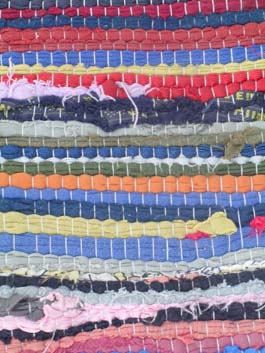
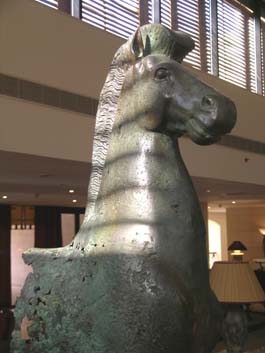
A Medley of Images from Jordan
Jordan is a non-stop photo-op, and a visual
metaphor-a-minute experience.
 To view a slideshow of various images
from Jordan, CLICK
HERE
To view a slideshow of various images
from Jordan, CLICK
HERE
The
Jordan Travel and Tourism Industry
To
watch a short video of Jordan, CLICK
HERE. (With a high speed Internet connection, this
video opens in QuickTime.
Please be patient as the video is about 36 minutes in length.)
This
video has been provided to Talking Travel by the Jordan North American
Tourism Board. In addition to the beautiful images of Jordan, the
video also gives insight into the travel and tourism industry in
Jordan.
As
is the case in other sectors of Jordanian society we observed, this
nation is progressive and forward-thinking in terms of the travel
and tourism industry. Its “National Tourism Strategy 2004
- 2010" is a comprehensive and laudable business plan that
has identified the following as priority niche markets: Cultural
Heritage (Archeology); Religious; Eco-tourism; Health and wellness;
Cruising; Meetings, incentives, and events (MICE); Adventure; and
Summer and Family holidays. The plan also emphasizes "sustained
growth" and that "tourism should deliver the optimum benefit
to the economy, people, and communities of Jordan."
The
document also contains a section devoted to Social Equity in which,
among other stated priorities, the travel and tourism industry In
Jordan will emphasize that "Tourism should contribute to poverty
alleviation...," should be "inclusive and involve people,
culture and communities," should "always consider social
impacts and the potential deterioration of underlying resources
and should plan to minimize them...," and "should invest
in skill development and training to enhance human resource development..."
One
particular statement contained in the document struck a chord with
us:
"In
this very fragmented and complex industry, the single universal
commonality shared among all public and private stakeholders is
the traveler who seeks to navigate seamlessly around the globe from
destination to destination and supplier to supplier, and complete
multiple transactions in a secure environment."
When
in Jordan, Do as the Jordanians
Roy,
Peter, and Bob personally recommend the following:
- A
walk in the Souq in Old Amman
- Blue
Fig restaurant and night club
- Visit
a local school if you can arrange it.
- Dinner
or lunch at the Kan Zaman restaurant in Amman
- Lunch
at the UM Khalil House when visiting Jerash
- A
real Turkish bath (The Salome) in Petra, especially after
the arduous but once-in-a-lifetime five-hour hike from Little Petra
to The Monastery
- A
cruise with lunch and snorkeling from Aqaba on the Red Sea (see
www.sindbadjo.com).
You will marvel at the fact that you are looking at Jordan, Egypt,
and Saudi Arabia.
- Dinner
under the stars at The Grill at the Moorish-style Mövenpick
hotel at the Dead Sea.
- Covering
yourself with the mineral-rich black mud from the Dead Sea and then
floating on the top of the latter
Looking
for a Tour to Jordan?
For a
list of tour operators who specialize in Jordan CLICK
HERE.
Resources
See
Jordan (The North American Jordan Tourist Board Website)
Visit
Jordan (The International Jordan Tourist Board Website)
Royal
Jordanian Airlines
The
King Hussein Website (the Father of Modern Jordan)
The
Middle Eastern Meetings, Incentives, Conferences, and Exhibits (MICE)
Website for Jordan
The
Jordan Ministry of Tourism and Antiquities
First
Jordan: Multilingual Business and Tourism Portal
Jordanian
embassies around the world
|
|
|
Interesting
and important remains of the Umayyads can be found to the east of
Amman in the form of a series of “desert castles” where
Ummayad caliphs repaired for pleasure and relaxation, escaping the
duties and pressures of office. The beautiful frescoes of Qusayr
Amra, one of the best preserved of these “pleasure palaces,”
depicts scenes of musicians, nude women bathers, hunters, banquet
scenes, and scantily-dressed dancing girls. All of this appears
to be in stark contrast to traditional Islamic artistic prohibitions,
and is an indication of just how liberal the Ummayads were in their
approach to the enjoyment of good living.
In
the centuries that followed a series of rival Islamic dynasties
struggled for control of the Middle East. Among them were the Abbasids
of Baghdad, the Fatimids of Cairo, and finally the semi-nomadic
Seljuk Turks, who swept out of central Asia to control the region
by the end of the 10th century. This period had seen the flowering
of Islamic culture throughout the Middle East, North Africa, and
Muslim Spain, which included the preservation and translation of
a number of nearly-lost Greek and Roman classical writings, such
as those of Plato and Aristotle. Arab doctors, scientists, philosophers,
and engineers made startling advances in their respective fields
of study at a time when most of Europe was plunged into the Dark
Ages. The debt the West owes to Islam for nurturing and enhancing
the cultural achievements of antiquity is great indeed, and not
always recognized to the extent it deserves.
However,
despite these significant cross-cultural exchanges, the Christian
and Muslim civilizations were destined to enter into a prolonged
and bitter struggle. The conflict was to be fought over control
of the holy places of Jerusalem during the Crusades, and it began
in 1095 when Pope Urban II called on the feudal knights of Europe
to recapture them from the Islamic “infidels.” For the
next 200 years, Jordan and the rest of the Middle East became a
battleground between the clashing armies of the Christian cross
and the Islamic crescent. Perhaps the most important historic site
from this dramatic era is the imposing castle of Karak located on
the King’s Highway south of the city of Madaba. Karak was
a Crusader stronghold, built by a French nobleman known as King
Baldwin I of Jerusalem in 1142. The castle’s next ruler was
the sadistic Renauld de Chatillon, who enjoyed tossing prisoners
over the steep castle walls into the abyss below. The great and
chivalrous Saladin, the Kurdish-born Muslim leader who battled against
Crusaders such as Richard Coeur-de-lion, captured Karak after an
epic seige in 1183. Upon discovering that a wedding celebration
was taking place inside the castle, Saladin asked in what part of
the building the newlyweds were spending their wedding night. He
then instructed his catapult engineers to avoid targeting that part
of the castle. For this the bride’s mother rewarded the Muslim
leader and his troops with some of the delicacies from the wedding
feast!
Following
the end of the Crusades and the departure of the Christian knights
from the Middle East, Jordan was ruled by the Mamluks, a group of
ex-slaves from Cairo who had risen up against their overlords and
established their own Islamic kingdom. The Crusader castles were
recaptured and turned into staging posts for message-bearing pigeons.
But the Mamluks, fierce and disciplined fighters, who had been able
to withstand the onslaught of the Mongol hordes of Genghis Khan,
eventually fell to the advancing Ottoman Turks by the early 16th
century. The succeeding centuries of Ottoman rule, from the splendid
capital of Istanbul in Turkey, brought some important economic and
social changes to Jordan, although it was not an important part
of their empire. By the early 20th century, the Arab peoples of
the Middle East were becoming restive and resentful of their Turkish
overlords, and during World War I the “Arab revolt”
against Ottoman rule, aided by Britain, spread throughout Jordan.
The huge flag of that revolt dominates the harbour of Aqaba to this
day, in honour of the fighters who first raised their standard against
the Ottomans in 1915.
Contemplating
Confronted
by the more technologically advanced civilizations of Europe, the
Arab world faced some serious dilemmas regarding how to respond
as the 20th century progressed. One group of Arab scholars and leaders
advocated a policy of westernization and modernization that would
enable the region to advance and defend itself against further encroachments
of European colonialism. But another faction argued that the only
hope for the Arabs lay in a return to the fundamentals of their
Islamic culture, and a firm rejection of western ways. It is obvious
from contemporary events that this struggle for the soul of the
Arab peoples has still to be resolved. But in Jordan, at any rate,
the forces of modernization, coupled with a strong determination
to preserve the essentials of the country’s Arab identity
and Islamic tradition and culture, appear to be on the ascendant.
Since 1946, they have been strongly promoted by the country’s
two main rulers since independence, the father and son team of Kings
Hussein and Abdullah.
Under
Hussein’s rule Jordan’s troops twice took up arms against
Israel, during the 1948 struggle after Israel’s creation under
United Nations auspices, and again in the Six Day War of 1967. Both
of these military conflicts brought serious hardship to the country,
with thousands of Palestinian refugees flooding into Jordan for
safety ahead of advancing Israeli forces. After the 1967 defeat,
Jordan lost control of East Jerusalem and the West Bank, which fell
under Israeli control. In addition, the country’s political
situation was further complicated and destabilized by the presence
in Amman of Yasser Arafat’s guerrilla group, the Palestine
Liberation Organization, which Hussein finally expelled from Jordan
during after a bloody month-long struggle known as “Black
September” in 1970. Since then, both King Hussein and his
son Abdullah have been forces for restraint and moderation in the
Middle East, a region where the shrill voices of extremism are all-too-frequently
heard on both sides of the yawning Arab-Israeli divide.
Jordan’s
rulers in the post-independence era have faced a number of serious
challenges, some of which continue to confront King Abdullah and
his ministers today. Lacking the bountiful oil reserves of neighbouring
Arab states, Jordan has been obliged to adopt other strategies for
economic development. Among the most important of these is of course
tourism, which accounts for approximately 10 per cent of its GDP
and is growing steadily. Water has also been a serious resource
problem, for Jordan is a primarily arid, desert country with scanty
and infrequent rainfall. The Jordan River, which it shares with
Israel, is its primary source of that precious commodity, and much
of the country’s thriving agricultural activities in the Jordan
valley in the north depend on it. One of the most important clauses
in the 1994 Jordan-Israel peace agreement dealt with just how the
waters of the Jordan River were to be equitably shared between the
two countries. The country’s welfare state, a model for much
of the rest of the Arab world, is administered by a number of agencies
sponsored by various members of the royal family. Education, health
care, and other social services are available to citizens throughout
the country, and Jordan stands at 90 in the United Nations’
Human Development Index, one of the best scores for any Middle Eastern
country with the exception of Israel and the oil-rich Gulf states.
Jordan
is certainly an oasis of peace in a very troubled region of the
world. The basically pro-American foreign policy, and its willingness
to sign a comprehensive peace treaty with its former enemy Israel
in 1994 has won it generous grants of foreign aid from the United
States and other western countries. However, as an Arab nation,
Jordan has firmly endorsed the demands of the Palestinians for their
own viable and independent state, and has strongly criticized Israeli
policies, such as the summer 2006 war against Lebanon and the continuing
occupation of Palestinian land. Both King Hussein and his son Abdullah
have sought tirelessly to use their good offices with Washington,
Tel Aviv, and other western capitals to bring about a comprehensive
resolution to this ongoing conflict that would be acceptable and
just to both parties. To date, however, there is unfortunately very
little progress to show for these efforts. In an interview with
western reporters during the summer 2006 war, King Abdullah expressed
the view that if this dispute were not solved soon, it could drag
on for decades, with negative impacts not only for Jordan, but for
the entire Middle East region.
Since
the introduction of a limited form of parliamentary democracy, leading
to the enfranchisement of women and the formation of political parties,
it has been possible for ordinary Jordanians to express their views
on important national issues. The main opposition group in Parliament
is a fundamentalist faction known as the Islamic Action Front (IAF),
closely linked to the Egyptian-based Muslim Brotherhood. However,
the power of the elected Parliament to influence the King and his
ministers in their formulation of government policy is limited.
For this reason, it is difficult to determine the extent of the
influence of Islamic fundamentalism over average Jordanians today.
Personalizing
However,
I was able to derive some impressions from the frequent and very
open conversations with a number of Jordanians from all walks of
life that I was able to have during my visit. Most of them, from
Palestinian-born taxi drivers to middle-class tourism professionals,
view themselves as Arab “moderates,” strong supporters
of secular democracy at home and a just settlement of the Israel-Palestine
dispute. These are the very people whose interests and goals U.S.
President George W. Bush claims his policies are designed to promote
throughout the Middle East. But the common thread of all these very
interesting discussions was a growing sense of frustration on their
part that the unbalanced, unquestioning pro-Israel policy of the
current American administration was in fact backfiring, playing
directly into the hands of Islamic extremists and making their own
moderate position increasingly untenable. They could only hope that
a more equitable viewpoint might emerge from whatever president
entered the White House after the 2008 election.
Assessing
In
November 2005 Amman was rocked by a deadly series of bombings that
took over 60 lives and damaged three of the capital’s major
hotels. Al Qaeda claimed responsibility for these terrorist acts,
intending to harm Jordan’s lucrative tourist industry and
punish King Abdullah’s government for its pro-American policies
and diplomatic ties with Israel. While we were in Jordan, we were
aware of the impressive security measures that the government had
taken in the wake of these tragedies, including armed guards and
metal barriers in front of the hotels we visited. Security checks
at the major historic and archaeological sites, such as Petra, were
also very thorough, although never intrusive or intimidating.
A
tragic and unfortunate incident did in fact take place in Amman
while we were visiting the country. An apparently deranged individual
opened fire on a group of tourists who were touring the impressive
remains of the Roman theatre in Amman, killing one British man and
wounding a few others. It was indeed a bitter irony that this incident
should have occurred in the middle of our visit to Jordan, and we
received news of it while touring the magnificent ruins of Petra.
The reaction of the entire group to this event was unhesitating
and unanimous — we wanted to continue with our tour without
any changes in itinerary, no additional security and ample opportunities
to meet and converse with ordinary Jordanians. In fact, while we
had visited the old market area of Amman, a neighbourhood very close
to the Roman theatre, we had been struck by the degree of friendliness
and courtesy with which we had been received by local merchants
and shoppers. Later, when I heard news reports that this area was
perceived as a “hotbed of Islamic fundamentalism,” and
“hostile to foreigners,” I had to wonder whether I had
been in the same part of Amman that these very distorted and uninformed
reports were describing.
Jordan’s
government and people are aware of the difficulties they face in
overcoming negative perceptions of their country and its tourist
potential. In meetings we held with a number of senior political
officials, including the Minister of Tourism, the Minister of the
Environment, and a senator and close advisor to King Abdullah, these
issues were raised and addressed in a very open and frank manner.
As part of its effort to promote its many and fascinating tourist
attractions, Jordan is ambitiously developing a number of “market
niches” for potential visitors. Among these are eco-tourism,
concentrated in spectacular nature preserves such as Dana, archaeological
travel, with sites such as Petra and Jerash at the top of the list,
and finally Biblical or religious tourism, based in holy sites such
as the Dead Sea, Mount Nebo, and Bethany. Jordan’s tourist
infrastructure is world-class, and the country offers a wide range
of accommodations from five-star hotels to more modest guesthouses
scattered across the country. One of the most memorable of our nights
in Jordan, however, had to be the night we spent sleeping out under
the stars in the magical, moonlit desert of Wadi Rum. Most of the
major tourist sites are easily accessible by car or bus. While most
first-time visitors to Jordan would probably opt for an organized
tour, the country’s transportation infrastructure is advanced
enough to offer ample opportunities for the independent traveller
to explore the country on his or her own.
Jordan’s
cuisine is also varied and always delicious. Middle Eastern food
is of course the main staple, but it is possible to sample dishes
from other parts of the world, including Italy and China, in cities
like Amman. There were two memorable meals that particularly stand
out among the many we enjoyed during our visit. The first of these
was definitely the mensaf, or chicken with rice, which
the group had the opportunity to prepare for itself in the Petra
Kitchen, under the watchful expert supervision of the assembled
cooking staff. The second was zerb, a feast of chicken,
lamb, and rice that was cooked in a huge cauldron beneath the baking
desert sands of Wadi Rum. When it was ready to eat, our Bedouin
guides dug it out of the sand after nightfall, their efforts illuminated
by the headlights of the four-wheel vehicles that had transported
us to that marvellous desert oasis. Feasting on this delicious dish
alfresco and under the stars was a truly once-in-a-lifetime experience.
On
the last day of our visit, as the bus took us from our Dead Sea
hotel back to Amman for the flight home, I felt a strong desire
to continue my visit to Jordan. Failing that, I hoped at least to
return sometime soon to see the places I had been unable to visit
this time. The JNTB had provided us with a very thorough and well-organized
itinerary, enabling the group to visit some of the most interesting
and impressive sites Jordan has to offer. But there was still so
much more that I wanted to see, especially the desert “pleasure
palaces” and the spectacular nature preserve of Dana. Jordan
is a small country with much to offer the visitor, but perhaps its
most attractive feature is the genuine warmth, generosity, and hospitality
of its wonderful people. During our trip, we were invariably greeted
with the expression, Ahlan wa sahlan! This means “Make
yourself at home and be at your ease!" We were always made
to feel that way in Jordan. I am sure that anyone who is able to
move beyond the misperceptions he or she may have of this delightful
country will come away with an entirely different and positive perspective
on the Hashemite Kingdom and its many rich and varied charms.
|
|
|









